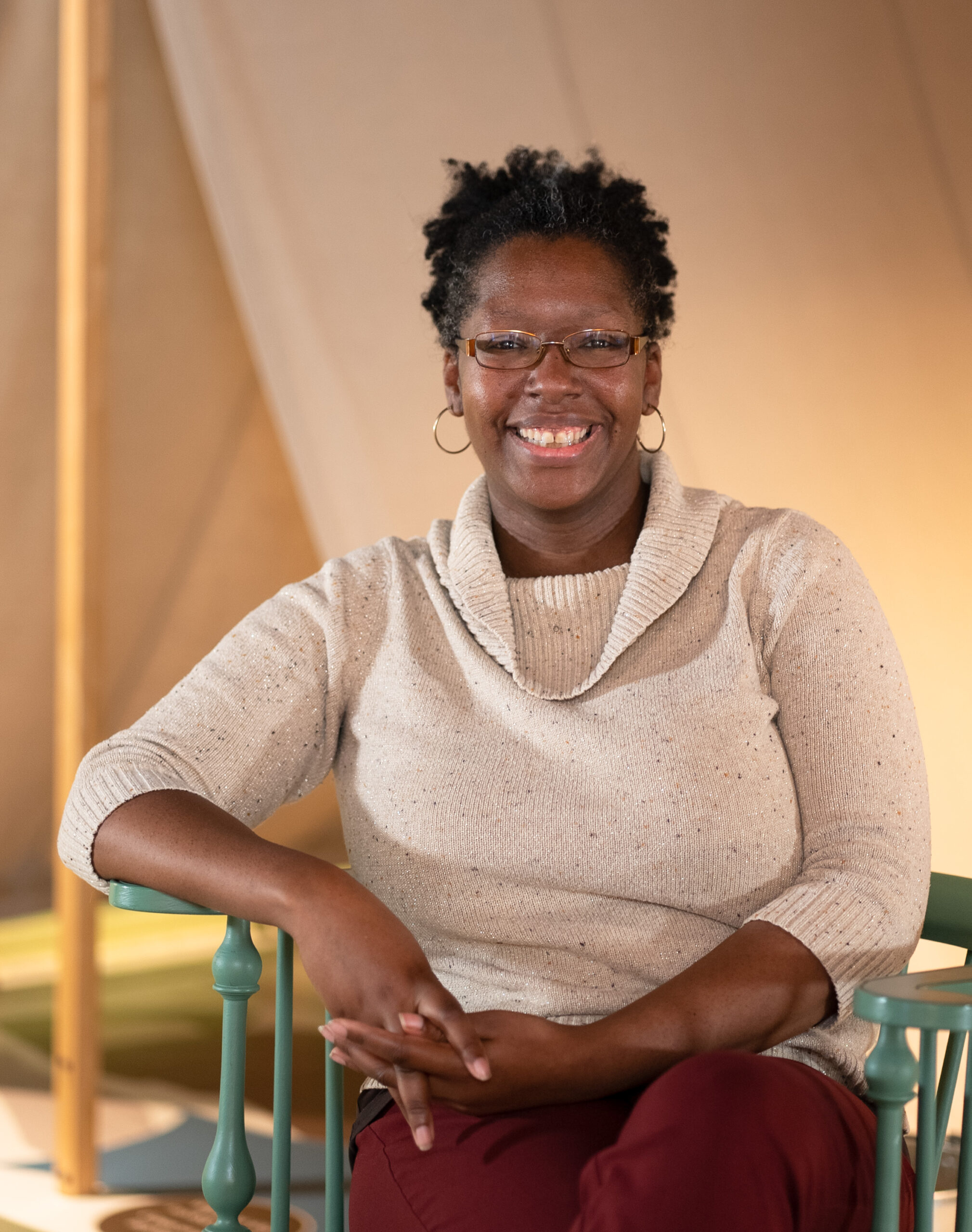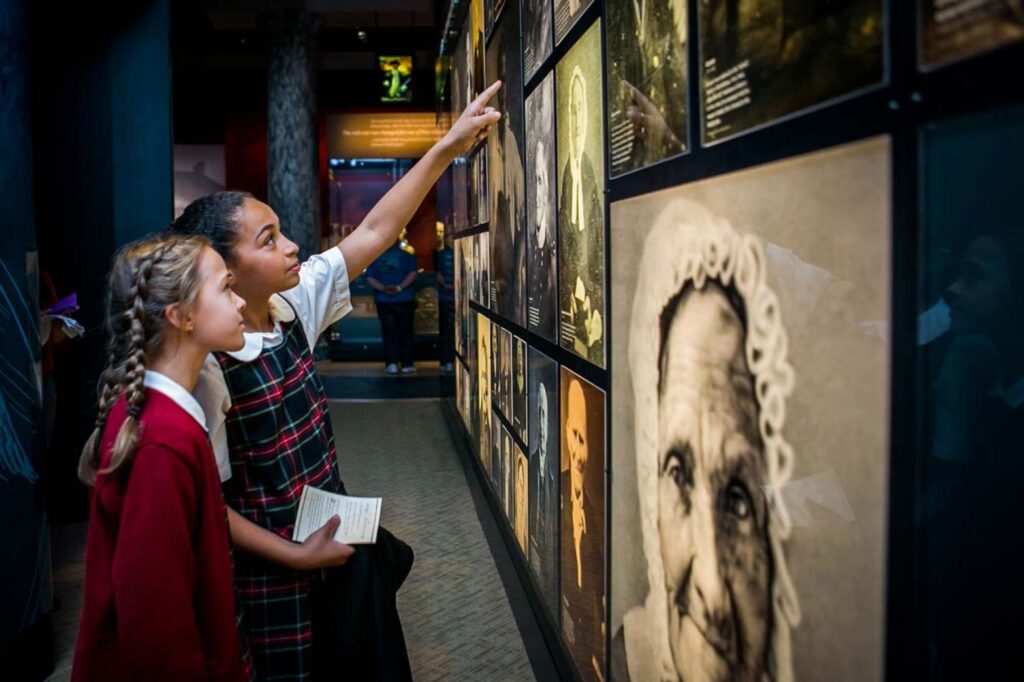
Photo: MoAR
By Constance Garcia-Barrio
Years ago, Adrienne Whaley, director of education and community engagement at the Museum of the American Revolution (MoAR), located at Third and Chestnut Streets, had expected to stroll into corporate boardrooms in three-inch heels carrying a hand-tooled leather briefcase. But history cast its spell and swept her in a different direction.
Born in West Philadelphia and raised in Germantown and East Mt. Airy, Whaley grew up in a household with lots of books, an encyclopedia, and educational toys. Frequent visits by Whaley, her brother, and her sister to the Lovett Library and Northwest Regional Library further broadened their vistas.
By her high school years, Whaley envisioned earning a Wharton School MBA, but, lo and behold, a tombstone helped to change her mind.
“My history class at Masterman High School took part in the Cemetery Project at The Woodlands,” Whaley said of an excursion to the 54-acre burial ground, founded in 1840, at 4000 Woodland Avenue. To enter into the spirit of the 1800s, she and her classmates were told to bring only lunch items that people would have had at that time.
The class split up into groups, each of which picked a gravestone.

Students explore galleries at the Museum of the American Revolution (MoAR)
Photo: MoAR
“We researched the name on the gravestone at the Historical Society of Pennsylvania, the Library Company of Philadelphia, and other sites,” Whaley said.
The project roughly coincided with Whaley’s reading Toni Morrison’s “Song of Solomon” in her English class. The novel’s protagonist, Milkman — so nicknamed because he breastfed until the age of four — discovers that a rhyme children sung while playing games was really about his family’s history. The novel provided Whaley with another revealing lens on the past.
Captivated by these perspectives, Whaley plunged into learning about her own ancestors. Still a highschooler, she boarded a Greyhound bus for Columbus, Ohio, to visit her father’s family. Few young people had their own cellphones at the time, so she carried her father’s cellphone to stay in touch during the 11-hour trip.
Whaley interviewed her grandmother, aunts and uncles, and cousins. She asked them about family stories as well as recipes they used, from whom they’d learned them, and what the dishes meant to them.
“I combined the recipes and stories into a cookbook called “Family Preserves,” Whaley said. Within six years, Whaley had earned a bachelor’s degree in African American Studies from Harvard and a master’s degree in education from the University of Pennsylvania.
Meanwhile, her love affair with Black ancestry deepened. She served as president of Philadelphia’s African American Genealogy Group from 2017 to 2021.

Photo: MoAR
Before joining MoAR in 2016, Whaley held positions at New York’s Museum of Modern Art, the African American Museum in Philadelphia, and the Smithsonian’s Anacostia Community Museum.
Whaley considers presenting a broad, diverse look at the American Revolution crucial. Many books and museums showcase George Washington and the 56 men in the Second Continental Congress who signed the Declaration of Independence in 1776. However, about 2.5 million people lived in colonies at the time. Some favored independence, others sided with England, and some stayed neutral. Whaley would like visitors to grasp the rebellion’s complexity, which means telling stories — based on primary sources like diaries and letters — often kept on the sidelines.
Accessibility also guides decisions about exhibits. MoAR includes facsimiles of original documents, many of them in cursive.
“Some kids haven’t been taught cursive, so there’s a transcription in print,” Whaley said.
In addition, instead of watering down vocabulary in MoAR’s print and online resources, potentially unfamiliar words are linked to a glossary.
“It allows people to step up to the text,” Whaley said.
The deeds of everyday people also gain prominence. Paul Revere’s midnight ride is legendary, but MoAR visitors can also learn, for example, about the women and children in Litchfield, Connecticut, who melted down a statue of King George III, ruler of England during the Revolutionary War, to make musket balls for the Continental Army.
Exhibits, a gallery guide, and a video at the museum explain the predicament of Native Americans, whose lands the war often ravaged.
Costumed and cultural interpretations by experts add to visitors’ understanding. Likewise, the many classroom resources for teachers include a poster that discusses the “more than 250,000 Native Americans [who] lived east of the Mississippi River in 1776.”
Some exhibits invite viewers to slip into the lives of Black Americans. Take the case of London, a 15-year-old boy enslaved in Virginia during the autumn 1781 Siege of Yorktown, the last major battle of the Revolutionary War.
“London had to decide whether to stay in Virginia, living enslaved to a Quaker owner who favored abolition, or join the British and board a ship to Nova Scotia, leaving behind everything and everyone he knew,” Whaley said. “The exhibit asks viewers what decision they would make.”
Try-on clothing and a discovery cart also make exhibits kid friendly.
Such comprehensive storytelling shines a light on other little-known Black Americans.
“Witness to Revolution: The Unlikely Travels of Washington’s Tent,” an exhibition that opened in February, traces the life of George Washington’s sleeping and office tent — now almost 250 years old — including the Black Americans who cared for it.
The tent still exists, thanks in large part to Selina Gray (1823-1901), a Black woman born into slavery at Arlington House, once the home of Confederate General Robert E. Lee and his wife, Mary Anna Randolph Custis Lee. Mary Anna, a great-granddaughter of Martha Washington, inherited the tent and other mementos from the Revolutionary War.
The Lees lived at Arlington House — now part of Arlington National Cemetery — just across the Potomac River from Washington, D.C. When the Civil War broke out in the spring of 1861, General Lee took to the battlefield and Mary Anna moved to Richmond, the Confederate capital.
“Mary Anna left Selina Gray, her personal maid and the head housekeeper in charge,” Whaley said. The Lees would never return to their former home.
The U.S. Army occupied Arlington House, which offered an excellent view of the strategic Potomac River. Selina Gray noticed that soldiers had begun stealing family treasures as souvenirs. Gray wrote to General Irvin McDowell, commander of the U.S. troops — enslaved Black people at Arlington were taught to read and write because the family considered it a duty — emphasizing the importance of the heirlooms.
McDowell had the remaining items, including the tent, taken to the U.S. Patent Office for safekeeping, according to Whaley.
Throughout the war, the Arlington estate also supported thousands of African Americans fleeing enslavement in the South. On December 4, 1863, the federal government dedicated Freedman’s Village, a planned community for freed slaves on the southern portion of the property.
Freedman’s Village grew to a community of 1,500, with a hospital, two churches, schools, and a home for the elderly.
In a letter to Mary Anna years after the war, Gray wrote, “I had to undergo a lot to stay at Arlington House.” A mural in the exhibition shows Gray with two of her daughters on Arlington lands.
“It’s a privilege and a joy to explore these stories with our guest,” Whaley says. “Perhaps that’s the connecting thread. I loved — and still love — books as a way to see into other people’s worlds. Now, I use the many stories of our nation’s diverse history to help others do the same.”
The exhibition, which runs through January 5, 2025, features comments from several of Gray’s descendants. For more information, visit: www.amrevmuseum.org.
















Leave a Comment